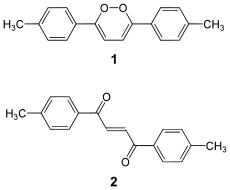- 1,2-Dioxin
-
Strukturformel 
Allgemeines Name 1,2-Dioxin Andere Namen - Dioxin
- o-Dioxin
Summenformel C4H4O2 CAS-Nummer 289-87-2 PubChem 15559065 Eigenschaften Molare Masse 84,07 g·mol−1 Sicherheitshinweise EU-Gefahrstoffkennzeichnung [1] keine Einstufung verfügbar R- und S-Sätze R: siehe oben S: siehe oben Soweit möglich und gebräuchlich, werden SI-Einheiten verwendet. Wenn nicht anders vermerkt, gelten die angegebenen Daten bei Standardbedingungen. 1,2-Dioxin, auch o-Dioxin, ist eine sehr instabile sauerstoffhaltige heterocyclische organische Verbindung, die noch nicht isoliert werden konnte. Selbst substituierte Derivate sind sehr labil, beispielsweise das 1,4-Diphenyl-2,3-benzodioxin.[2]
(kein) stabiles 1,2-Dioxin
1990 wurde fälschlicherweise das 3,6-Bis(p-tolyl)-1,2-dioxin für das erste stabile Derivat gehalten.[3] Jedoch wurde gezeigt, dass es sich bei der Verbindung nicht um ein Derivat eines 1,2-Dioxins (1), sondern um ein (thermodynamisch deutlich stabileres) Dion (2) handelt.[4]
Stabile Derivate
Ersetzt man die Sauerstoffgruppen mit Schwefelgruppen, erhält man sogenannte 1,2-Dithiine. Diese sind häufig Naturstoffe und wirken antimikrobiell, wie zum Beispiel die Thiarubrine. Auch 1,2-Diselenine konnten isoliert werden. Schließlich ist auch das Isomer 1,4-Dioxin (p-Dioxin) im Gegensatz zum 1,2-Dioxin stabil.
Einzelnachweise
- ↑ In Bezug auf ihre Gefährlichkeit wurde die Substanz von der EU noch nicht eingestuft, eine verlässliche und zitierfähige Quelle hierzu wurde noch nicht gefunden.
- ↑ J. P. Smith, A. K. Schrock, G. B. Schuster: Chemiluminescence of organic peroxides. Thermal generation of an o-xylylene peroxide, in: J. Am. Chem. Soc. 1981, 104, 1041–1047; doi:10.1021/ja00368a021.
- ↑ H. J. Shine, D. C. Zhao: Electron transfer to excited doublet states. Photoirradiation of 10-methylphenothiazine cation radical perchlorate in solutions of phenylacetylene and p-tolylacetylene in acetonitrile, in: J. Org. Chem. 1990, 55, 4086–4089; doi:10.1021/jo00300a026.
- ↑ E. Block, Z. Shan, R. S. Glass, J. Fabian: Revised structure of a purported 1,2-dioxin: a combined experimental and theoretical study, in: J. Org. Chem. 2003, 68, 4108–4111; PMID 12737603; doi:10.1021/jo034305i.
Kategorien:- Dioxin
- Hypothetische chemische Verbindung
Wikimedia Foundation.



